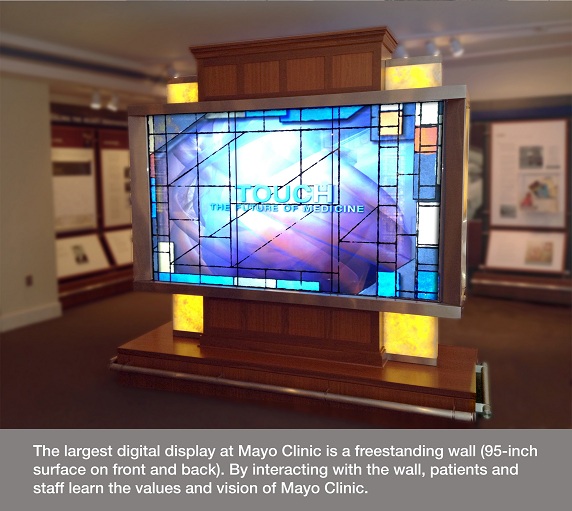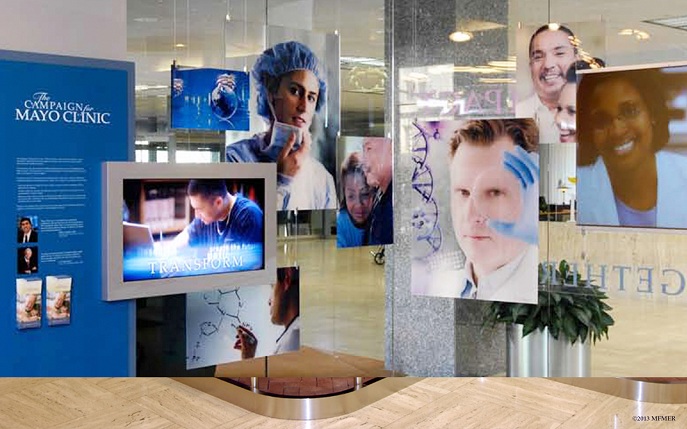Patient Experience And Design At Mayo Clinic: Case Study

By Sharon Erdman, Patient Experience and Design, Mayo Clinic
“Wonderful place – comforting and inspiring.”
“I learned a lot and had fun!”
“I couldn’t wait to show my husband.”
“Makes me proud to work here.”
Comments like these – whether tweeted on mobile devices, written in a guestbook or shared in conversation – express the loyalty and enthusiasm that every healthcare organization wants from its patients and staff.
What prompts such positive responses? They come spontaneously when people encounter displays and environments that we create through an initiative called Patient Experience Design. A dynamic presence at Mayo Clinic, this concept is readily transferrable to other organizations.
The goal of Patient Experience Design is to “express organizational culture through physical spaces.” Most medical centers have attractive public areas; some hospitals display works of art. But do your patients and staff know the ethos of your organization … the qualities that make it unique and set it apart from the competition … your historic accomplishments and goals for the future? Patient Experience Design brings those attributes to life in ways that are informational, inspirational – and strategic.

We use the techniques of the museum profession to create displays that reveal the “personality” and priorities of Mayo Clinic. Artifacts, graphics, text and digital signage can be applied in many ways to meet any budget. Result: An empty wall by an elevator or the bypassed corner of a lobby becomes a destination – a place that compels interest and starts conversations, building support for the organization.
Our projects range from a single framed element that is displayed near an office …to in-depth, multimedia spaces that elevate benefactor recognition … and mobile exhibits that travel around the country. We are an interdisciplinary service that unites administration, facilities, design, philanthropy, public affairs, media, technology and contract workers.
While every environment that we create is unique, Patient Experience Design is built upon five themes:
- Assessment – What does the organization want to accomplish? We focus on grand messages that reflect the institution’s culture and strategy. Examples might include raising benefactor support, promoting diversity, highlighting the role of education at a teaching hospital or showing the impact of research on patient care.
- Message – We develop a narrative that brings each grand message to life. Descriptions, quotations, letters, speeches, stories, news coverage, then/now comparisons and frequently asked questions are all resources to construct a narrative that attracts interest.
- Location – Exhibits succeed when they complement their venue. We tell stories differently in a busy hallway vs. a quiet alcove. We also pay attention to carpet, wall color, light and other environmental factors, as well as the function of the area. As a result, each exhibit becomes integral to own its space – not an “add on.”
- Toolbox – These are the resources that personalize the story to the organization. To showcase your electronic medical record, for example, you could compare it with the paper records from your history – patients and staff will see that while technology changes, your mission remains the same. Even humble objects – a nurse’s cap from years gone by, a letter from a grateful patient, the program from an auxiliary event – become inspiring artifacts when presented with text, graphics or electronic information. You might display a historic document under Plexiglas; print a quotation from a patient or early leader of your organization as a headline; or create a “digital family album” of staff and benefactors.
- Context – Exhibits need care and feeding. Too often, for example, an organization goes to the expense of creating, printing and installing a timeline – with no plan to keep it current. Or digital displays go dark. But beyond ensuring that information is updated and maintenance is performed, there are great opportunities to connect displays and environments with the life of your organization. A docent-led tour, for example, or a self-guided itinerary for patients, visitors and employees, helps ensure ongoing interest in the exhibit. Displays in a public venue become an ideal backdrop for institutional events and news coverage.
 Along with delivering content, our environments speak to “purpose of place.” From break rooms to cafeterias and auditoriums, your staff and patients are already gathering together. These venues provide an easy-win opportunity to add informative and inspirational displays that offer depth of meaning, while also supporting the designated use of the area.
Along with delivering content, our environments speak to “purpose of place.” From break rooms to cafeterias and auditoriums, your staff and patients are already gathering together. These venues provide an easy-win opportunity to add informative and inspirational displays that offer depth of meaning, while also supporting the designated use of the area.
The next time you see a blank wall or a generic-looking conference room, think of it as a blank canvas to express the values and vision of your organization. Through Patient Experience and Design, we have found that one of the most effective ways to boost the bottom line is to touch the human spirit.
 Author Sharon Erdman will be presenting a case study of ”Patient Experience & Design at Mayo Clinic,” at Digital Signage Expo 2013 in Las Vegas on Wednesday, February 27. For more information about DSE or to register to join this or any other seminar and learn about digital signage go to www.DSEnow.com
Author Sharon Erdman will be presenting a case study of ”Patient Experience & Design at Mayo Clinic,” at Digital Signage Expo 2013 in Las Vegas on Wednesday, February 27. For more information about DSE or to register to join this or any other seminar and learn about digital signage go to www.DSEnow.com
Copyright 2012 Mayo Foundation for Medical Education and Research. All rights reserved.
About The Author
Sharon Erdman currently directs Patient Experience Design at Mayo Clinic – a $26 B internationally recognized health care organization. Sharon provides a comprehensive vision for patient experience through the method of patient-centered environmental design. With each project being firmly rooted in Mayo Clinic’s heritage, history, vision and values, the spaces positivity affect a patient’s understanding of Mayo Clinic’s commitment to quality, safety, education and the unparalleled care Mayo delivers every day.
